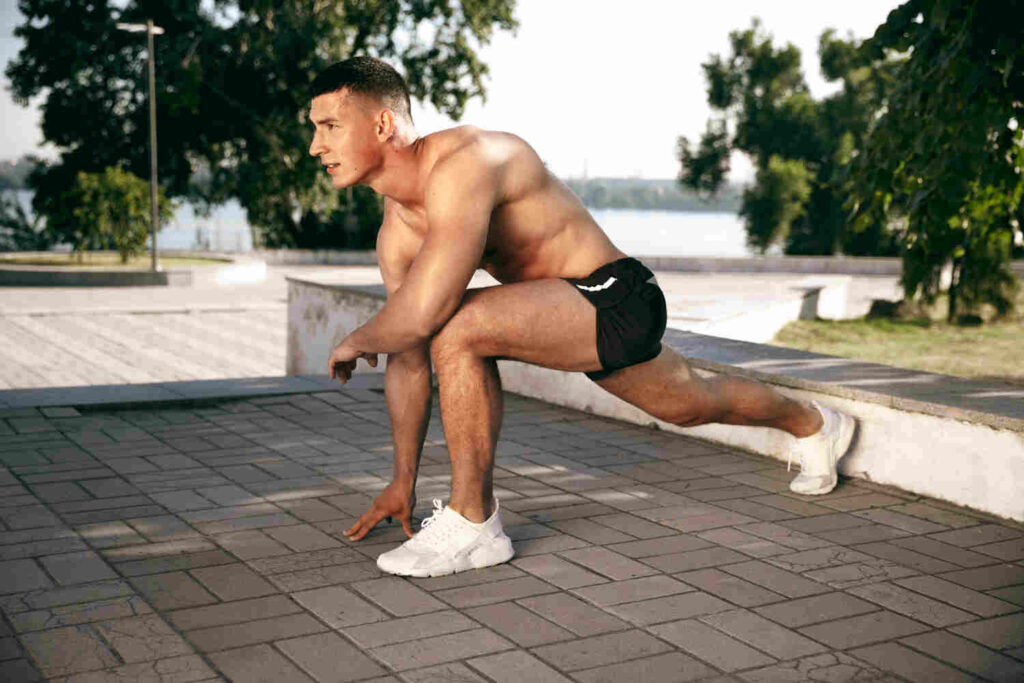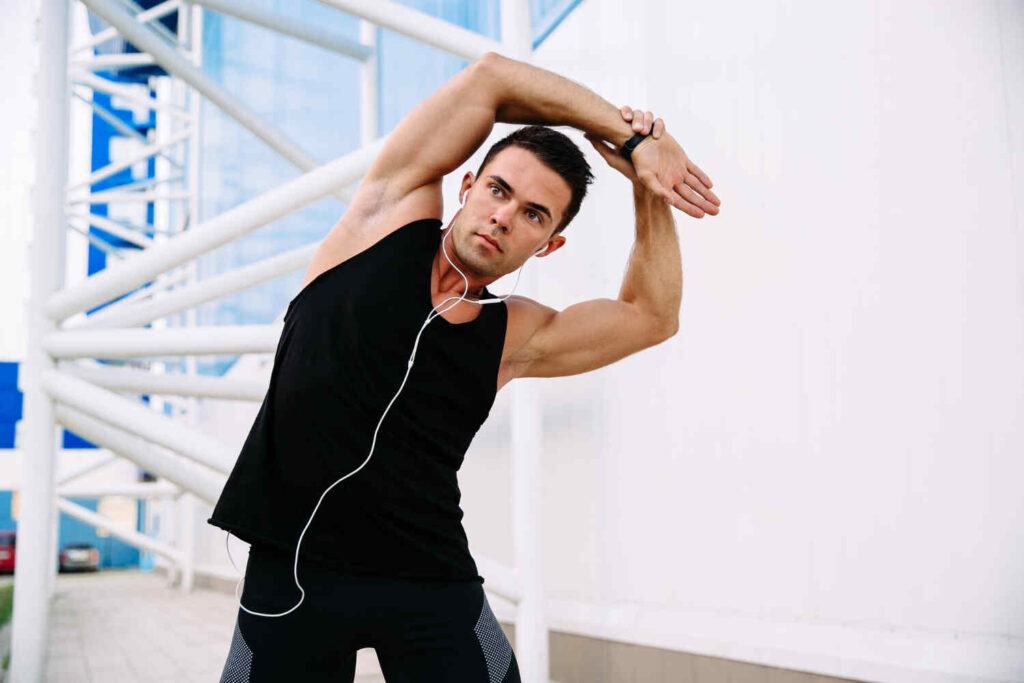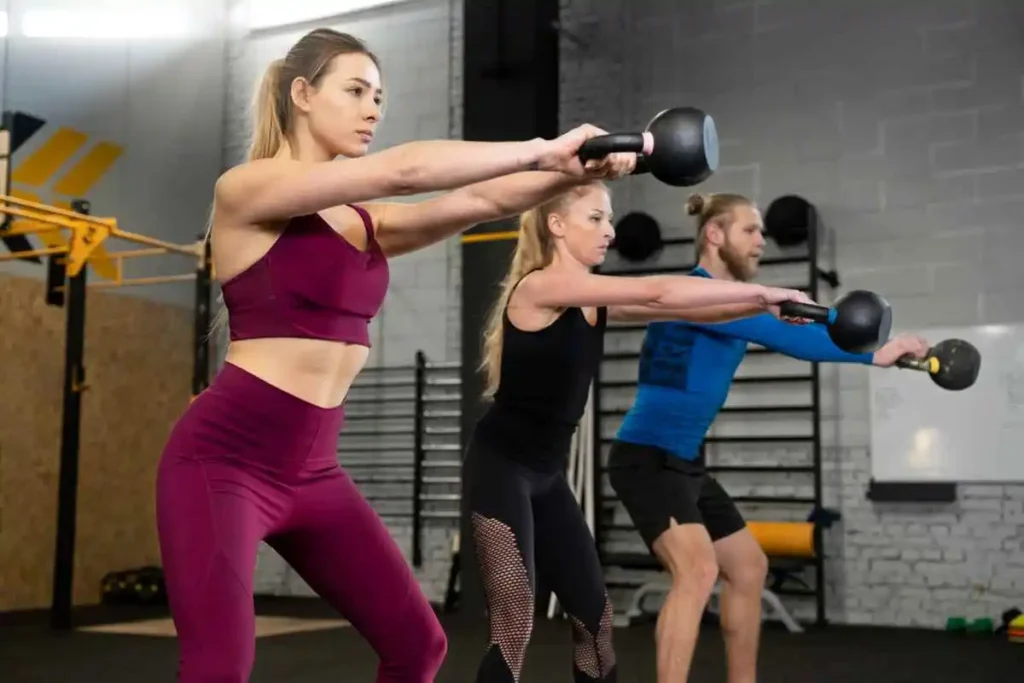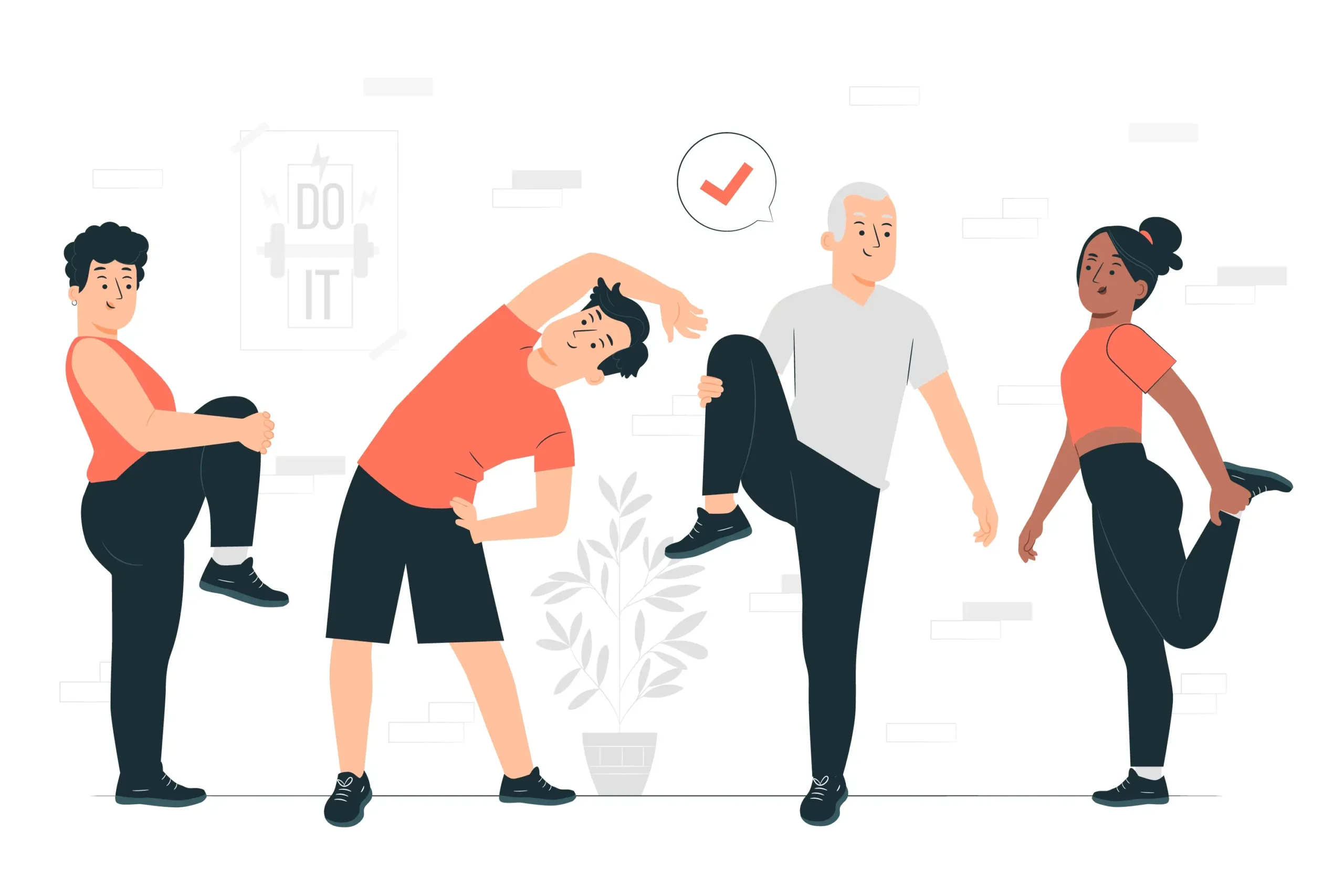Introduction
In the pattern of physical wellness, stretching emerges as a universal language, speaking not only to the muscles but echoing the wisdom of diverse traditions. This deliberate elongation of muscles and connective tissues serves as a bridge connecting us to ancient practices, deeply rooted in the fabric of our collective heritage.
Table of Contents
ToggleIn this exploration of stretching, we will research into its definition, historical meaning, and the countless benefits of stretching. From improving flexibility and preventing injuries to promoting stress reduction and enhancing overall physical performance, the positive effects of stretching are diverse and extend to both the body and mind.
To guide you through this journey, we will provide an overview of the various types of stretching techniques each with its own advantage and characteristics. As we solve the secrets of stretching, lets enhance the journey towards flexibility, well-being, and a better understanding of the role stretching plays in an achieving holistic health.
What is stretching?
Stretching is a type of workout where we extend our body soft tissues along with muscles. During the stretching session we make different posture that allow us to extend our muscles and tissues beyond their natural limit. There is a lot of ways to accomplished this and we normally use these methods in our workout routine, like before or after workout for warmup and cool down routine. To get maximum benefits of stretching we need to include this in our daily workout routine.
Purpose of stretching

The primary purposes of stretching include:
Improving Flexibility: Stretching helps increase the range of motion in joints and enhances flexibility. Athletes, dancers, and individuals engaging in physical activities with a wide range of motion might find it very helpful.
Enhancing Performance: Stretching before physical activities can improve muscle function and efficiency, leading to better overall performance.
Injury Prevention: Regular stretching of body is believed to reduce the risk of injuries by maintaining or improving the flexibility of muscles and connective tissues. This may help prevent strains, sprains, and other soft tissue injuries.
Relieving Muscle Tension: Stretching can help alleviate muscle tightness and tension, promoting relaxation. It is important for those who spend long periods in sedentary positions or engage in repetitive activities that can lead to muscle stiffness.
Improving Posture: Stretching exercises that target specific muscle groups can contribute to better posture by correcting muscular imbalances and promoting alignment.
Types of Stretching

Static Stretching
Explanation of static stretching:
Static stretching involves holding a stretch position for an extended period without movement. It is typically done in a slow and controlled manner, targeting specific muscles or muscle groups. The goal is to gradually lengthen the muscles and improve flexibility.
Examples of static stretching exercises:
Hamstring stretch
Quadriceps stretch
Shoulder stretch
Calf stretch
Triceps stretch
Benefits of static stretching:
It helps in increasing flexibility and range of motion and Improved muscle relaxation and reduce tension in muscle and also Enhanced muscle coordination.
Dynamic Stretching
Explanation of dynamic stretching:
Dynamic stretching involves controlled, active movements that take a joint or muscle through its full range of motion. Unlike static stretching, dynamic stretches are usually performed in a more dynamic and rhythmic manner. It is mostly used in warm-up routine before engaging in physical activities.
Examples of dynamic stretching exercises:
Leg swings
Arm circles
High knees
Walking lunges
Hip circles
Benefits of dynamic stretching:
It Improve blood circulation and increased heart rate and also Enhanced neuromuscular coordination and provide greater flexibility and range of motion .and prepares the body for more intense physical activity.
PNF(Proprioceptive Neuromuscular Facilitation)Stretching
Explanation of PNF stretching:
PNF stretching is a technique that involves a combination of stretching and contracting specific muscles. It often includes a partner to assist with the stretching. PNF methods aim to improve flexibility through a series of contract-relax cycles.
Techniques involved in PNF stretching:
Contract-Relax: Contracting the target muscle for a few seconds before relaxing into a stretch. Hold-Relax: Similar to contract-relax, but involves isometric contractions at different points in the range of motion.
Benefits of PNF stretching:
Rapid gains in flexibility Enhanced neuromuscular control and coordination Effective for improving range of motion
Ballistic Stretching
Explanation of ballistic stretching:
Ballistic stretching involves using bouncing or jerking movements to push a muscle or group of muscles beyond their normal range of motion. It differs from static stretching as it employs momentum and forceful actions.
Examples of ballistic stretching exercises:
Leg swings with a bouncing motion
Arm circles with rapid movements
Bouncing toe touches
Caution and potential risks of ballistic stretching: Increased risk of muscle and joint injuries Potential for overstretching and muscle strains Not recommended for individuals with certain medical conditions or beginners
Note: Ballistic stretching is generally considered less safe than other stretching methods and is not commonly recommended, especially for those who are not properly conditioned or experienced in stretching technique
Benefits of Stretching

Improved Flexibility
Explaining: Regular stretching increases the length of muscles and connective tissues, enhancing flexibility. Allows joints to move more freely and reduces the risk of muscle imbalances.
Importance:
Improved flexibility contributes to better overall physical performance and reduces the likelihood of injury.
Enhanced Range of Motion
Explaining: Stretching helps joints achieve their full range of motion. This is crucial for activities requiring dynamic movements and agility.
Importance: Increased range of motion promotes more efficient and effective body movements during physical activities.
Injury Prevention
Explaining: Stretching prepares muscles and connective tissues for physical exertion, reducing the risk of strains, sprains, and other soft tissue injuries.
Importance: Including stretching in warm-up routines can contribute to the prevention of exercise-related injuries.
Increased Blood Circulation
Explaining: Stretching promotes blood flow to muscles, delivering oxygen and nutrients. This helps in reducing muscle soreness and facilitates a quicker recovery.
Importance: Improved blood circulation supports overall cardiovascular health and aids in the efficiency of physiological processes.
Stress Reduction
Explaining: Stretching induces a relaxation response, releasing tension in muscles and calming the nervous system.
Importance: Incorporating stretching into a routine can be a valuable component of stress management and mental health promotion.
Improved Posture
Explaining: Targeted stretching can address muscular imbalances, leading to better alignment and improved posture. This is particularly relevant for individuals with sedentary lifestyles.
Importance: Good posture is essential for preventing musculoskeletal issues and promoting overall body balance and functionality.
variety of stretching techniques into a well-rounded fitness routine can maximize these benefits. It’s important to tailor stretching exercises to individual needs and activities, ensuring a balance between different types of stretches for optimal results.
When to perform stretching

Pre-Workout Stretching
Rationale: Pre-workout stretching is essential for preparing the body for physical activity. It helps increase blood flow to the muscles, raises the body’s temperature, and enhances flexibility, reducing the risk of injury during subsequent exercise.
Guidelines: Focus on dynamic stretching rather than static stretches before a workout. Perform stretches that mimic the movements of the upcoming activity. Hold each stretch for a shorter duration (around 15-30 seconds) to avoid overstretching.
Post-Workout Stretching
Rationale: Post-workout stretching aids in the cool-down process and promotes muscle recovery. It helps prevent stiffness and soreness by elongating muscles that may have contracted during exercise.
Guidelines: Include both static and dynamic stretches in the post-workout routine. Hold static stretches for a slightly longer duration (around 30-60 seconds) to promote muscle relaxation. Pay extra attention to muscles that were heavily engaged during the workout.
Incorporating Stretching into Daily Routine
Rationale: Stretching can be beneficial when integrated into a daily routine, not just around workouts. It helps maintain flexibility, prevent muscle tightness, and contributes to overall well-being.
Guidelines: Incorporate short stretching sessions throughout the day, especially if you have a sedentary lifestyle. Focus on areas prone to tension, such as the neck, shoulders, and lower back. Use static stretches to relax muscles, and consider incorporating mindfulness or deep breathing for added relaxation benefits.
Remember, individual preferences, the specific type of exercise, and personal fitness goals can influence the timing and type of stretching. It’s essential to listen your body and adjust your stretching routine based on your needs Additionally those who have injuries or health concerns should consult with a professional or a qualifies fitness professional before involving stretching into your routine.
Which type of stretching are good for building muscles?

Relationship between stretching and muscle building
Explanation: While traditional strength training is essential for muscle building, incorporating certain stretching techniques can complement and support this process. Stretching can enhance flexibility, joint mobility, and overall muscle function, contributing to better performance during strength training exercises.
Importance: Improved flexibility allows for a full range of motion during squats, deadlift, bench press and other multi-muscles targeting resistance training, optimizing muscle engagement and promoting better muscle development.
Specific stretching techniques beneficial for muscle growth
Dynamic Stretching:
Dynamic stretching basically performed before the workout start, it helps to increase blood flow to the muscles and tissues and activates the nervous system, preparing the body for strength training.
Benefits: Enhanced range of motion, improved muscle activation, and increased blood circulation contribute to more effective muscle engagement during resistance exercises.
PNF (Proprioceptive Neuromuscular Facilitation) Stretching
PNF stretching involves a combination of stretching and contracting specific muscles. When used strategically, it can contribute to increased muscle flexibility and function.
Benefits: PNF stretching can be integrated into a comprehensive training program to improve muscle elasticity and optimize muscle performance.
Static Stretching in Between
Performing static stretches in between sets of strength training exercises may help maintain or improve flexibility, preventing muscle tightness.
Benefits: Enhanced flexibility can contribute to better form and muscle engagement during subsequent sets, potentially improving muscle-building outcomes.
Balancing stretching and strength training

Guidelines Dynamic Warm-up: Prior to strength training, incorporate dynamic stretching to warm up the muscles and prepare them for the upcoming workout.
Static Stretching Between Sets: Include static stretches during rest periods between sets to prevent muscle tightness and maintain flexibility.
Post-Workout Stretching: After completing strength training, add a post-workout stretching routine to promote muscle recovery and prevent stiffness.
Considerations Timing: While dynamic stretching is beneficial before strength training, extensive static stretching before heavy lifting may temporarily reduce muscle strength. Save intense static stretching for the cool-down phase.
Individual Needs: Adjust the intensity and type of stretching based on individual fitness levels, goals, and any existing injuries or limitations.
Remember, the primary focus of muscle building is strength training. While stretching can complement these efforts, it should be integrated thoughtfully and in alignment with individual goals and fitness plans. Consultation with fitness professionals or trainers can provide personalized advice based on specific needs
Conclusion
In conclusion, stretching is a fundamental and versatile component of a healthy lifestyle, offering a countless of benefits for both the body and mind. Through our exploration, we’ve covered benefits of stretching, various types of stretching, each with its own purpose and advantages.
From the deliberate elongation of muscles in static stretching to the dynamic, rhythmic movements of dynamic stretching, and the strategic combination of stretching and contraction in PNF stretching, there are diverse ways to enhance flexibility, range of motion, and overall muscle function. We’ve also touched upon the caution needed with ballistic stretching due to its potential risks.
The relationship between stretching and muscle building was discussed, emphasizing how incorporating dynamic stretching, PNF stretching, and strategic static stretching can complement traditional strength training. This integration contributes to improved muscle engagement, flexibility, and overall performance.
Above all, the conclusion underscores the importance of incorporating stretching into a well-rounded fitness routine. finding a perfect stretching schedule that suits your needs is key, whether you’re an athlete, fitness passionate, or someone trying to improve their overall health and fitness.
In encouraging readers to explore and personalize their stretching routines, we celebrate the uniqueness of each individual’s fitness journey. Stretching not only contributes to physical health but also fosters mindfulness and stress reduction, promoting a holistic approach to overall wellness. May it bring strength, resilience, and a sense of fulfillment to all who embark on this mindful and purposeful endeavor.

